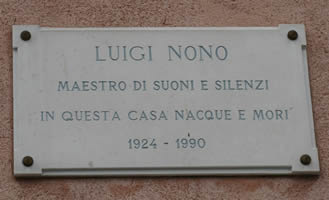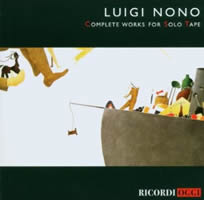Maestro di Suoni e Silenzi: Necessary Nono 1.
|
Grant Chu Covell [March 2011.] A recent trip to Italy brought me to Venice, but timing prevented visiting the Luigi Nono Archive (http://www.luiginono.it/). While wandering through La Serenissima, we did accidentally discover this commemorative plaque on the Zattere:
I’ve postponed covering a stack of relatively recent Nono releases, music impossible to contemplate casually. Here is the first of three installments.
“Luigi Nono: Complete Works for Solo Tape.” Luigi NONO: Omaggio a Emilio Vedova (1960); Musiche di scena per Ermittlung (1965); Ricorda cosa ti hanno fatto in Auschwitz (1966); Contrappunto dialettico alla mente (1967-68); Musiche per Manzù (1969); Für Paul Dessau (1974). Stradivarius STR 57001 (2 CDs) (http://www.stradivarius.it/). Distributed in the US by Allegro Music (http://www.allegro-music.com/). Despite Nono’s fluency with live electronics, it takes prompting to recall that he created several works for tape alone. Perhaps these pieces are unfamiliar to North American ears because most contain political content; Nono’s Communist values, despite his anti-Nazi, anti-Fascist stance, have made Americans uncomfortable. When I think of Nono’s work with tape, the instrumental combinations …sofferte onde serene… with piano and La lontananza nostalgica utopica futura with violin are what jump to mind. Nono’s electronic innovations were not with these “fixed” tape pieces, but in works that utilized real-time delays or loudspeakers positioned throughout the venue sculpting live players’ sounds. Such techniques are barely hinted at in these works except in the plastic way Nono handled content from recordings of his own music. Berio and Maderna founded the Studio di Fonologia at the RAI in Milan in 1955. Nono had been angling to work there, and an invitation came in 1960. His first solo tape item is the five-minute concrète Omaggio for fellow Venetian Emilio Vedova, a painter who designed the sets and costumes for Nono’s Intolleranza 1960 and later Prometeo. The completely synthesized materials are divorced from vocal or instrumental precedent. Musiche di scena per Ermittlung and Ricorda cosa ti hanno fatto in Auschwitz use the same ingredients. Nono had been asked to provide music for Peter Weiss’ play, Die Ermittlung (The Investigation) about the Auschwitz trials then taking place in Frankfurt. For the Berlin production, Nono produced many varied-length snippets, assembled here in Musiche di scena per Ermittlung with intervening cue tones. The next year Nono returned to the materials and fashioned the independent Ricorda cosa ti hanno fatto in Auschwitz. In addition to synthesized materials, Ermittlung/Ricorda manipulate excerpts from Diario polacco, Cori di Didone and Ha Venido: canciones para Silvia as well as older recordings of soprano Stefania Woytowicz along with fresher material capturing the children’s chorus of Milan’s Piccolo Teatro. The jumble of percussion, orchestra and voices achieves a granitic power. As brief, intruding bits, the material had to have been striking during the play. Reduced and restructured into just over 11 minutes, Ricorda makes a Varèsian impact. Contrappunto dialettico alla mente is something like a parody, derived from a 1608 madrigal by Adriano Banchieri while also relating to Nono’s A floresta é jovem e cheja de vida. Where Ricorda emphasizes instruments and song, Contrappunto employs speech. Venetian fish market and water sounds infuse texts commenting upon the assassination of Malcolm X and other political topics. Despite the work’s density and virtuosic transformations, thinking it might offend American sensibilities, the RAI failed to recommend it for the Prix Italia. In a style more characteristic of late Nono, Musiche per Manzù offers a smeared chorus and synthesized tones moving slowly and alluringly. This same material, presumably shortened, was intended to accompany a film about the sculptor Giacomo Manzù’s new doors for a Rotterdam cathedral damaged in a Nazi raid. With Für Paul Dessau Nono commemorated his East German composer / colleague’s 80th birthday. Bits from Nono’s own Il canto sospeso, Non consumiamo Marx and Como una ola de fuerza y luz appear as well as extracts from speeches by Lenin, Castro and Che Guevara. The leaders’ overlapping declamations force an unexpected didactic encounter. Originally there were to have been live players alongside the tape. All we have now is 7:07 of solo tape work. Portions of radio broadcasts complete the set: an Italian announcer introducing Ricorda on March 21, 1970, and 23:56 of Contrappunto analysis from November 17, 1968. (Is Nono one of the speakers?) Stradivarius includes a 72-page booklet in Italian and English with detailed, somewhat cumbersome notes. Several technical issues remain obscure, e.g., whether there still exist multi-track versions (four-track or more) of these pieces. Comparing previous releases of the same tape works may be a futile exercise; after all, the fixed tape ought to remove any possibility of change. However, tape that can decay can also be digitally cleaned. A discussion of sound quality would be worthwhile. Its title lacking the dedicatee’s first name, Omaggio a Emilio Vedova appears on Wergo WER 6229-2 (with Canti di vita e d’amore in a single track and Per Bastiana) at a stronger dynamic. The older 1993 CD offers a slightly richer range, with the Stradivarius set suggesting the Wergo is a stereo mix. DG 423 248 offers Contrappunto dialettico alla mente (with Como una ola de fuerza y luz and …sofferte onde serene…) and lists the performing musicians: Liliana Poli, Cadigia Bove, Marisa Mazzoni, Elena Vicini, Umberto Troni and the RAI Chamber Choir led by Nino Antonellini. Bundled with La fabbrica illuminata and Ha Venido: canciones para Silvia, you can hear Ricorda cosa ti hanno fatto in Auschwitz on Wergo WER 6038-2. The notes, entirely in German, indicate the source musicians: Stefania Woytowicz and the Childrens’ Choir of the Piccolo Teatro di Milano. RAI sound engineer Marino Zuccheri receives well-deserved credit. Ricorda cosa ti hanno fatto in Auschwitz’s inchoate sweeping follows two modern but Romantic-influenced piano sonatas (Ullman’s No. 7 and Hartmann’s “27 April 1945”), making a shocking contrast on Fonit Cetra NFCD 2034.
Luigi NONO: Guai ai gelidi mostri (1983)1; Quando stanno morendo (Diario polacco no. 2) (1982)2. Heike Heilmann2, Petra Hoffmann2, Alexandra Lubchansky2 (sop), Noa Frenkel1, Susanne Otto1, 2 (alt), Roberto Fabbriciani1, 2 (bass-fl), Ernesto Molinari1 (clar), Klaus Burger1 (tuba), Susan Knight1 (vla), Christine Theus1, 2 (vlc), Ulrich Schneider1 (cbs), EXPERIMENTALSTUDIO des SWR1, 2: Michael Acker, Reinhold Braig, Joachim Hass, André Richard1, 2 (cond.). Neos 10801/02 (2 SACDs) (http://www.neos-music.com/). Distributed in the US by Qualiton (http://www.qualiton.com/). “20 Jahre Inventionen V.” Luigi NONO: Quando stanno morendo (Diario polacco no. 2) (1982)1; Canciones a Guiomar (1962/63)2; Omaggio a Emilio Vedova (1960). Ingrid Ade1, Monika Bair-Ivenz1, Bernadette Manca di Nissa1, Halina Nieckarz1 (voices), Roberto Fabbriciani1 (bass-fl), Frances-Marie Uitti1 (vlc), Arturo Tamayo1 (cond.), EXPERIMENTALSTUDIO der Heinrich-Strobel-Stiftung des SWR1, Luigi Nono1, Hans-Peter Haller1, Rudolf Strauss1, Bernd Noll1, Alvise Vidolin1 (sound, electronics), Edelgard Neubert-Imm2 (sop), Ars Nova Ensemble Berlin2, Peter Schwarz2 (cond.). Edition RZ 4006 (1 CD) (http://www.edition-rz.de/). Neos bundles two 2007 recordings of late-period Nono items; Edition RZ documents music played at Berlin’s Inventionen festival in 1983 and 1991. With its unique scoring and live-electronic demands, Quando must be among Nono’s most recorded works. Texts for both works were organized by a fellow Venetian, the philosopher Massimo Cacciari, who later served as Venice’s mayor. The rarely comprehensible words become fodder for electronic transformations accompanied by a few processed instruments. Additionally, the venue’s intrinsic resonance renders no two performances as ever the same. Quando’s three-part format shifts its focus from voices to instruments then back to voices. Guai’s four unevenly sized movements (27:40, 7:34, 0:40, 8:22 here) contain much less delineation between the two altos and the instruments. As with the previous decades’ work, the emotional intensity remains the same despite refinements. Nono’s outrage might be sparked by universal concerns instead of specific 20th-century injustices. When the 1982 Warsaw Autumn festival evaporated after Jaruzelski declared martial law, Nono resolved to complete the music he’d been asked to contribute, resulting in Quando stanno morendo (Diario polacco no. 2). (The first Polish diary was the 1959 Composizione no. 2 per orchestra: Diario Polacco ’58.) Quando may be somewhat easier to digest even as it alternates calm with violence. Breathy bass flute and mistuned cello (the player must actually use three instruments, each with all four strings tuned to microtones surrounding F, F-sharp or C) contrast with the women’s hovering voices. Sopranos in unison might emit a single pitch, gently processed with electronics, with a looped amplified instrument soon becoming oppressive. Quando’s central section can be terrifying in this regard. Inspired by four assemblages about the Venetian Carnival by fellow local Vedova, Guai achieves a bewildering blend of desolate murmurings, rasping textures and piercing beacons. More than in Quando, Cacciari’s assembled texts become fragmented, reduced to vowels or so spread across long durations as to be incomprehensible. André Richard also conducted a previous 1994 recording (Montaigne MO 782047) under the aegis of the same electronic music studio, yet this recording is more subtle and phlegmatic. Neos’ Quando (38:58) is dry and less terrifying than a previous col legno SACD (WWE 1SACD 20603). Of course Edition RZ’s Quando (37:46) acoustic possesses less contrast, yet seems bolder. Richard’s treatment, authoritative because of his association with Nono, demonstrates malleability and sensitivity. The cast of Edition RZ’s February 1983 Quando recording contains forces similar to those that premiered the work the preceding October. Canciones a Guiomar was performed on February 10, 1991. Omaggio was played five days before, and Edition RZ provides a copy of the master tape as expected, though at a louder dynamic level than the Stradivarius release, which makes for a more aggressive five minutes. Canciones places a wandering solo soprano in front of a dozen female singers, percussionists, guitar, viola, cello and bass. Edelgard Neubert-Imm coasts above glittering chimes, suspended cymbals and hushed strings. The chorus emerges towards the end in intricate dissonant chords. Patterned plucking and close-position string chords suggest a defective hurdy-gurdy. Such emulation is unusual in Nono. If the right electronics had been possible in the early ’60s, no doubt Machado’s love poems would have been transformed.
[More
Nono]
[Previous Article:
Bruckner’s Mass No. 2]
[Next Article:
Mostly Symphonies 17.]
|



